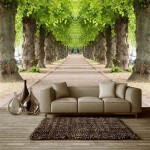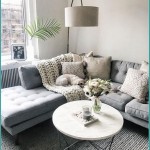```html
Living Room Decor With Dark Brown Couch
A dark brown couch possesses an inherent versatility that makes it a central piece in a variety of living room designs. Its neutral undertones allow it to adapt to diverse color palettes and styles, ranging from contemporary minimalism to rustic warmth. Understanding how to effectively leverage its anchoring presence is crucial for creating a cohesive and visually appealing living space.
The selection of complementary colors plays a pivotal role in determining the overall ambiance of the room. Light and airy shades, such as cream, beige, and pale gray, create a striking contrast against the deep brown, brightening the space and preventing it from feeling too heavy or somber. These lighter hues can be incorporated through wall paint, rugs, and accent furniture. Conversely, a monochromatic approach, utilizing varying shades of brown and tan, can establish a sophisticated and calming environment. Textural variations within this palette become essential for adding depth and visual interest.
Beyond color, the choice of materials and textures significantly influences the aesthetic appeal. Incorporating natural elements, such as wood, stone, and woven fabrics, enhances the warmth and earthiness of the dark brown couch. Conversely, sleek metal accents and glass surfaces can introduce a touch of modernity and sophistication. The strategic use of throw pillows and blankets, employing a mix of textures like velvet, linen, and faux fur, adds tactile richness and visual dimension to the seating arrangement.
Lighting is another critical factor in optimizing the look of a living room with a dark brown couch. Adequate lighting is essential to prevent the space from feeling gloomy. Layered lighting, combining ambient, task, and accent lighting, is generally recommended. Ambient lighting, such as overhead fixtures or recessed lighting, provides overall illumination. Task lighting, like floor lamps or table lamps, serves practical purposes for reading or other activities. Accent lighting, such as spotlights or wall sconces, highlights particular features of the room, such as artwork or architectural details.
The size and layout of the room also dictate the most suitable decor choices. In smaller spaces, it is important to avoid overcrowding the room with too much furniture or dark colors. Opting for lighter wall colors, mirrors, and strategic placement of lighting can help to create the illusion of more space. In larger rooms, the dark brown couch can serve as a focal point, around which other furniture and decor elements are arranged to create distinct zones for seating, conversation, or entertainment.
Key Considerations for Color Palettes
Selecting the right color palette is paramount to achieving a desired aesthetic. The goal is to either complement or contrast the dark brown couch in a manner that harmonizes with the overall style and mood. Three distinct approaches commonly employed include contrasting with light neutrals, embracing earth tones, and introducing bold accent colors.
Contrasting with light neutrals, as previously mentioned, is a widely favored strategy. This approach involves pairing the dark brown couch with walls painted in shades of cream, off-white, or light gray. A light-colored rug under the couch further brightens the area and visually anchors the seating arrangement. Accent pillows and throws in pastel hues or softer shades of blue or green add subtle pops of color without overwhelming the space. The key is to create a sense of equilibrium between the dark and light elements.
Embracing earth tones offers a more cohesive and naturalistic feel. This approach involves utilizing a range of brown, beige, tan, and olive green shades throughout the room. Walls can be painted in a warm beige or a muted olive green. Furniture made from natural wood, such as coffee tables and side tables, complements the dark brown couch. Area rugs in jute or sisal add textural interest and reinforce the earthy aesthetic. Accents in terracotta, rust, or ochre introduce subtle variations within the brown family.
Introducing bold accent colors can create a more dynamic and visually stimulating environment. This approach involves incorporating vibrant hues, such as teal, mustard yellow, or deep red, through accent pillows, artwork, and decorative accessories. The key is to use these colors sparingly to avoid overwhelming the space. A single statement wall in a bold color can also add significant visual impact. The dark brown couch serves as a grounding element, preventing the accent colors from feeling too chaotic or disjointed.
Textural Integration for Visual Depth
Texture plays a vital role in adding depth and visual interest to a living room featuring a dark brown couch. A room that relies solely on smooth surfaces can feel flat and uninviting. By incorporating a variety of textures, the space becomes more tactile and engaging. Three effective techniques include layering textiles, contrasting materials, and incorporating natural elements.
Layering textiles is a simple yet effective way to add texture to the seating area. Arrange a variety of throw pillows in different sizes, shapes, and textures on the dark brown couch. Consider using materials such as velvet, linen, faux fur, and knitted wool. Drape a soft throw blanket over the back of the couch or on one of the arms. The different textures create a sense of depth and invitation. Similarly, a textured area rug, such as a shag rug or a rug with a raised pattern, can add warmth and visual interest to the floor.
Contrasting materials involves juxtaposing smooth and rough surfaces, soft and hard elements, and matte and glossy finishes. Pair the dark brown couch with a coffee table made from metal and glass for a modern touch. Combine smooth leather accent chairs with woven baskets for storage. Introduce artwork with textured canvases or framed prints with ornate details. The interplay of contrasting materials creates visual tension and prevents the room from feeling monotonous.
Incorporating natural elements is another effective way to add texture and warmth to the living room. Displaying potted plants, such as ferns or succulents, introduces natural textures and adds a touch of greenery. Using wooden furniture, such as side tables or shelving units, adds warmth and visual interest. A stone fireplace surround adds a rustic touch. Woven baskets can be used for storage or as decorative accents. The inclusion of natural elements helps to create a more inviting and organic atmosphere.
Optimizing Lighting Strategies
Effective lighting is crucial for creating a welcoming and functional living room with a dark brown couch. Insufficient lighting can make the space feel gloomy and uninviting. Conversely, harsh or glaring lighting can be uncomfortable and unflattering. A well-designed lighting plan incorporates ambient, task, and accent lighting to create a balanced and versatile environment. Three key considerations include layering light sources, utilizing warm light bulbs, and incorporating dimmers.
Layering light sources involves combining different types of lighting to achieve optimal illumination. Ambient lighting, such as overhead fixtures or recessed lighting, provides overall illumination. Task lighting, like floor lamps or table lamps, provides focused light for reading or other activities. Accent lighting, such as spotlights or wall sconces, highlights particular features of the room, such as artwork or architectural details. By layering these different light sources, one can create a versatile and adaptable lighting scheme.
Utilizing warm light bulbs is essential for creating a cozy and inviting atmosphere. Warm light bulbs, with a color temperature of around 2700K-3000K, emit a soft, yellow-toned light that is more flattering and relaxing. Cool light bulbs, with a color temperature of around 4000K-5000K, emit a brighter, white-toned light that can feel harsh and sterile. Using warm light bulbs in all of the lighting fixtures will help to create a cohesive and inviting ambiance.
Incorporating dimmers allows for adjusting the intensity of the light to suit different activities and moods. Dimmers can be installed on overhead fixtures, table lamps, and floor lamps. This allows one to create a brighter environment for reading or working, or a more subdued environment for watching movies or relaxing. Dimmers also help to conserve energy and extend the lifespan of light bulbs. The ability to control the intensity of the light significantly enhances the versatility and functionality of the living room.
```
25 Beautiful Living Room Ideas For Your Manufactured Home Colors Brown Couch Design

Best Brown Couch Ideas For Your Living Room Farmhousehub

20 Best Dark Brown Leather Sofa Decorating Ideas And Designs 2025 Decor Couch Living Room

16 Cozy Dark Brown Couch Living Room Ideas For Any Aesthetic

Get Inspiration On How To Decorate With That Hefty Brown Couch Sofa Living Room Decor Colors

Best Brown Couch Ideas For Your Living Room Farmhousehub

Dark Brown Sofa Living Room Ideas Tips And Tricks

Chocolate Brown Sofa Design Ideas

16 Cozy Dark Brown Couch Living Room Ideas For Any Aesthetic

15 Fantastic Living Room Decorating Ideas For Brown Couch
Related Posts







